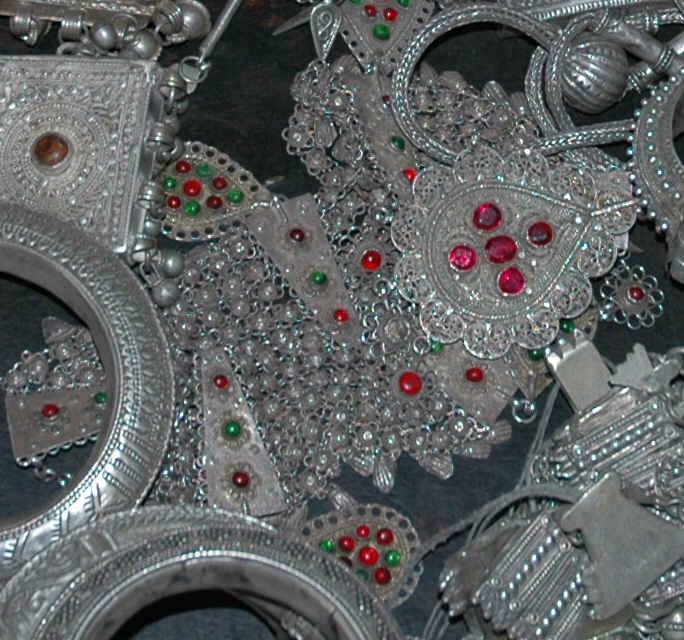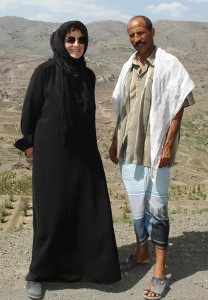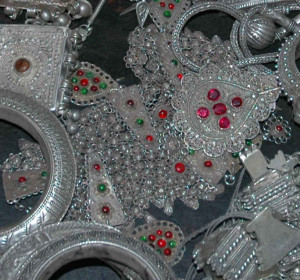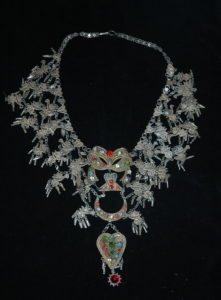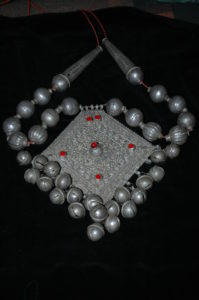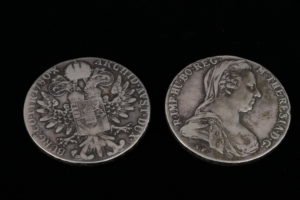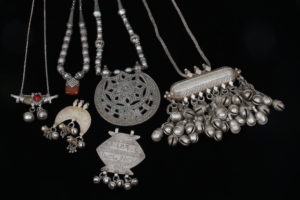is a Middle East specialist who has lived and worked throughout the Arab world, where she began researching and collecting traditional silver jewelry, particularly from Yemen.
Collector, curator and writer , she first showed her collection of traditional Middle Eastern silver jewellery in 2003 in Washington, D.C. It has since appeared in solo and group shows in New York, San Diego and at the Arab American Museum in Dearborn, Michigan. Ransom’s book, Silver Treasures from the Land of Sheba, was published by American University Press in April 2014. The book is available in our library to borrow.
This article, Silver Treasures from the Land of Sheba: A Synopsis has been written specifically for the Arab British Centre and we are extremely grateful to Marjorie Ransom for allowing us to publish this.
Marjorie has also written an article for Saudi Aramco on the young silversmiths who work in the old techniques. This can be viewed here.
Silver Treasures from the Land of Sheba: A Synopsis
Background
I grew up in a small village in northern New York – population 834. My late husband always said that there were more cows than people. I acquired in that tiny community an interest in people and their stories that served me well in my diplomatic career and was especially helpful when I began my research into Yemeni life. I had worked in Yemen as a diplomat twice before, but it was with some trepidation and self-doubt that I flew to Yemen in 2004 to immerse myself in a conservative society, asking silver dealers and silversmiths questions about their beautiful handicraft.
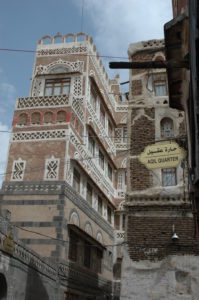
I had a great advantage being a woman of some years. I could travel with men and no one paid any special attention. I had always dressed conservatively in the Middle East, but Yemenis carry this a bit further. I started out wearing outfits that made me look like a south Asian. Yemeni men used to look at me and ask if I were Moroccan. Yemenis always look at what you wear because in their culture it tells where you are from and what class in society you belong to. I really puzzled them. It was only when my book advisor on the southern part of the country told me that I had to wear black before he would request entry into homes in the Hadramaut governorate that I made myself go out and buy black outer garments.
When I returned to my apartment in Sanaa from a successful trip to the Hadramaut I absentmindedly wore black in Sanaa for the first time on a walk through the market where I lived. Men called out to me – they always do this and as a woman you look straight ahead and keep moving. But they said, “Look at her!” She is dressed like us. She likes us!” I cannot tell you how much more acceptable I was in that black dress. It opened doors and broke down barriers. My book is based on interviews I conducted in Arabic while wearing black.
The Story
The tale of my book is one of exotic jewelryand costumes worn by Bedouin and tribal women. It was not city women who owned most of these treasures. There are a few instances in my book of jewelry worn by the urban elite; I make clear in the captions which pieces they are. Hundreds of silversmiths worked throughout the mountains, the oases and the sea coasts to make pieces to fit the special needs of their customers. The amount of jewelry in Yemen in the period that my book covers – 1900 to 1970 – was extraordinary. A poor Bedouin woman on the southern coast of Yemen’s largest governorate, the Hadramaut, said that when she married she had eleven kilograms or twenty-four pounds.
A Yemeni bride had to have new jewelry when she married; for that reason most pieces were not passed down from mother to daughter. Thus, the jewelry I write about in my book was made in the 20th century. Women began to give up silver jewelry and turn to gold in the 1960s; this explains why so many old pieces were available in the silver market during my research.
Why was jewelry so important in Yemeni society? There are several reasons but the most important was the role it played in the marriage contract. The family of the groom paid a large price for the right the groom to marry his bride. A good part of that payment was made in silver jewelry. At marriage the jewelry, according to Islamic law, became the property of the bride. In fact, it held the family wealth for Bedouin and tribesmen. They added to it in time of prosperity, e.g. when they sold their animals or harvested their crops, and they disposed of come of it in times of need or calamity. But the decision to sell some any jewelry was rightfully hers. Fatima, in a village near Zabid, sold all but one piece of her wedding jewelry to make a religious pilgrimage to Mecca. The one piece she could not bear to part with she kept locked in a metal box under her bed.
The jewelry was made from melted-down Maria Theresa thalers which came originally from the Austro-Hungarian Empire. The coins were always of 83.3% silver. So, in most cases the jewelry had that same percentage of silver. Thus, the women knew how much their jewelry was worth. If the price of silver fluctuated she could usually calculate the change in value of her pieces because she knew how much the pieces weighed. It functioned like a bank.
The jewelry identified the woman. First of all it told whether she was wealthy; the amount she wore reflected on the prestige of her husband and family. It indicated if she were a married woman. Sometimes this was by certain pieces, but in general young unmarried women had little jewelry to wear and they wore only simple pieces. Women acquired talismatic protection from the jewelry. She believed that certain shapes, color stones, and sounds protected her from evil. Sometimes she carried prayers in amuletic cases – cylinders and triangular and rectangular boxes that opened to carry a verse of the hold Quran or a prayer from a holy man. These protective pieces were special to different parts of the country. Here are amulets from the Hadramaut’s Wadi (valley) Duan.
Finally, the beauty of these pieces brought pride and pleasure to the women. The work of certain artisans was more valued than others and was sought out by the bride.
But I write of an era that started to dissolve in the early 1960s when women began to trade in their silver jewelry for a few gold pieces. The price of silver in relation to gold had fallen and it was impractical to hold the family treasure in massive amounts of silver which were not easily portable. When Yemeni workers flooded into Saudi Arabia in the 1970s during the oil boom they were exposed to other fashions and gold jewelry became more desirable. Silver jewelry became old-fashioned. The craft may disappear but Silver Treasures assures that it will not be forgotten.

